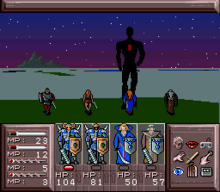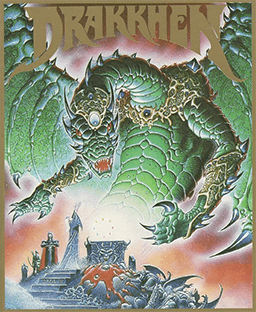Drakkhen
| Drakkhen | |
|---|---|
|
DOS cover art | |
| Developer(s) |
Infogrames Kemco-Seika (SNES) |
| Publisher(s) | Infogrames |
| Platform(s) | Amiga, Atari ST, DOS, SNES, PC-98, FM Towns Marty, Sharp X68000 |
| Release date(s) | 1989, 1990, 1991 |
| Genre(s) | Role-playing game |
| Mode(s) | Single-player |
Drakkhen is a 3D role-playing video game which was initially developed for the Amiga and Atari ST, and subsequently ported to several other platforms, including MS-DOS and the Super Nintendo Entertainment System.
Originally released by Infogrames in 1989, it was later modified for North American release by Draconian, a label from Data East, in 1990. Drakkhen was ported in 1991 to the Super Nintendo by Kemco-Seika, who made further revisions to the game.[1]
Drakkhen was notable for being among the first role-playing games to feature a three-dimensional playing field. It did not employ a fully 3D game engine, instead implementing a hybrid approach using vectors and bitmapped character-scaling algorithms. Drakkhen features an animated day-night cycle, and the ability to wander freely about the game world, both rarities for a game of its era.
The game spawned a sequel, Dragon View, for the SNES.
Background

The setting of Drakkhen is a large rectangular continent, divided laterally into four smaller regions. Each region features a unique terrain and climate, and is ruled over by two members of the elite Drakkhen caste, who all reside in their own keep. The continent is bounded on all sides by a vast ocean; walking into this, or any other body of water, will result in the speedy drowning of all of your party members.
Players create a party of four adventurers, choosing the gender and class of each.
Much of the game is spent travelling between castles, carrying out various political missions at the behest of the ruling Drakkhen elite. A player may wander around without having a particular goal or destination, perhaps in the spirit of curiosity, adventure, or exploration, or to fight wildlife, monsters, and strange supernatural entities, who will yield loot and experience points if they are defeated. Serious setbacks can easily occur through the death of one or more party members in combat, and bringing them back to life will often involve difficult and arduous travel in order to reach an Anak, where healing and resurrections are performed pro bono. If all four characters succumb to injury or drowning, the player will be informed of the dire consequences for the game world, before being returned to the title screen.
Storyline and gameplay

The storyline to Drakkhen lacked the complexity and pre-scripted dialogue commonly found in role-playing games of the time, and the plot was somewhat mystical and potentially confusing, which has been attributed to translation issues.
Drakkhen is known for its unusual sound effects; in lieu of speech, monsters and NPCs make noises that resemble belching, chittering, retching, or inarticulate rumbling. Early releases made only limited use of music during gameplay, but the game's soundtrack was expanded for the SNES version.[2]
A player may freely travel the length and breadth of Drakkhen's continent soon after beginning a new game, although this can be unwise in practice. Chance encounters with dangerous monsters are regular, and unlike many other RPGs, the player may be attacked while stationary. Players may attempt to flee from attacking monsters.

For the most part, enemy encounters occur randomly, though looking at certain stellar constellations at night can trigger an attack by a powerful, flying monster. Also, urn-like markers can be found at some crossroads; bumping into these immediately summons a large, black, stationary canine head that growls menacingly while shooting red energy bolts from its eyes. These encounters are quickly fatal if the player's party does not run, or is not heavily armored.
Another notorious enemy is the powerful "Shade of Doom", a tall, dark figure that would unexpectedly emerge from the ground, accompanied by an ominous tune. Fighting this monster at almost any point of the game meant certain death, which caused confusion among new players.
Continental divisions

- Arctic Wasteland
- Domain of the Prince and Princess of Air, both of whom live in large glacier-shaped castles.
- Swampland (dark green)
- Domain of the Prince and Princess of Water, the former living in a large castle and the latter in what resembles a pagoda. This area has the greatest number of rivers and lakes, all of which present drowning hazards.
- Grassland (light green)
- Domain of the Prince and Princess of Earth, who live in identical-looking fortresses. This is where the adventure begins. In the centre is a glowing boundary that is heavily guarded.
- Desert
- Domain of the Prince and Princess of Fire, the former living in what resembles an Aztec pyramid and the latter in a large Taj Mahal or mosque-like building (incorrectly called a "minaret").
In the original Amiga version, crossing the borders between continental divisions would require a wait while the game loaded. In the SNES version, crossings are instantaneous; however, if the player attempts to cross between areas prematurely, they are sharply rebuked.
Reception
Drakkhen attracted a modest cult following. The game was reviewed in 1990 in Dragon #160 by Hartley, Patricia, and Kirk Lesser in "The Role of Computers" column. The reviewers gave the game 4½ out of 5 stars.[3] Computer Gaming World in 1991 called the game "an interesting idea but poor implementation", criticizing pathing, documentation, and "terrible" character creation.[4] In 1993 the magazine stated that Drakkhen was "only for the patient".[5]
References
- ↑ "Hardcore Gaming 101: Drakkhen". Hardcore Gaming 101. Retrieved 2010-02-02.
- ↑ "Drakkhen Info".
- ↑ Lesser, Hartley; Lesser, Patricia; Lesser, Kirk (August 1990). "The Role of Computers". Dragon (160): 47–52.
- ↑ Scorpia (October 1991). "C*R*P*G*S / Computer Role-Playing Game Survey". Computer Gaming World. p. 16. Retrieved 18 November 2013.
- ↑ Scorpia (October 1993). "Scorpia's Magic Scroll Of Games". Computer Gaming World. pp. 34–50. Retrieved 25 March 2016.
